9 min read
Kanban: Definition, Method, Principles, Examples & Kanban Board
![]() Jens Walter
:
31.Oktober.2023
Jens Walter
:
31.Oktober.2023
In an ever-changing business world, where flexibility and efficiency are crucial, the Kanban method offers a proven way to optimize work processes and make them transparent. In this article, we will take an in-depth look at Kanban - from its basic definition to its key principles, concrete application examples and how a Kanban board works.
Learn how Kanban helps teams and organizations adapt to changing requirements, minimize waste and maximize the delivery of value to customers.
Content
- What is Kanban?
- How does Kanban work?
- What are the principles of Kanban?
- What are Kanban boards and how are they used?
- What are Kanban cards?
- Advantages of Kanban compared to other agile project management methods
- Kanban vs. Scrum: Similarities and differences
- Where is Kanban used? Application of Kanban and examples
- How BeeWaTec supports the Kanban method
- Conclusion and outlook
What is Kanban / what is the Kanban method? (Definition)
Kanban is a method of organizing work where tasks are usually visualized on a (physical or digital) Kanban board with different columns to track progress. Tasks move from one column to the next as they are processed. What makes Kanban special is that tasks are started only when capacity and demand allow, instead of starting them all at once. This helps to avoid bottlenecks, make the work process transparent, increase productivity and shorten lead times. Kanban is a flexible method that can be used in various application areas to optimize the workflow.
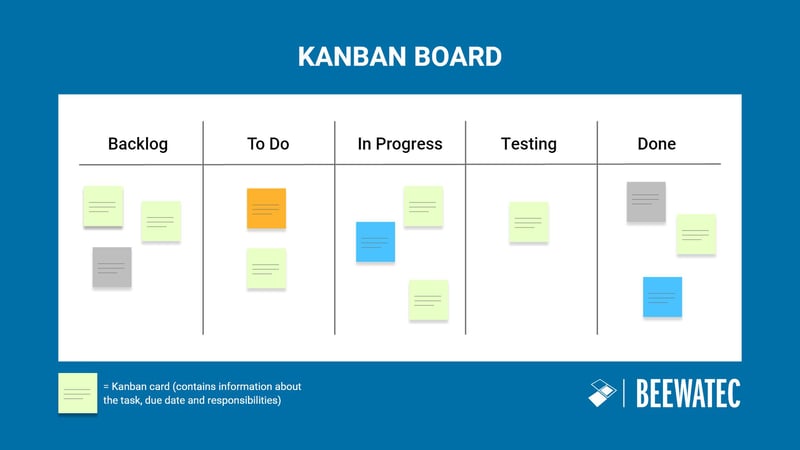
How does Kanban / the Kanban system work?
Kanban works in a quite simple and effective way. The Kanban system is usually based on a visual board on which tasks and work steps are displayed. It works as follows:
-
Kanban board: The heart of the Kanban system is a board with columns that reflect the progress of the work. Typical columns are "To Do," "In Progress," and "Done." This board can either physically hang on a wall or exist digitally in a software application.
-
Tasks as cards: Work is represented in the form of cards or slips of paper. Each card represents a task or step of work. These cards are placed on the Kanban board.
-
Movement of cards: Cards move from one column to the next to reflect the status of tasks. For example, when a task is started, the card moves from the To Do column to the In Progress column. When the task is completed, the card moves to the "Done" column.
-
Limitation of work: An important rule in Kanban is the limitation of work in the columns. This means that each column can have a maximum number of cards. This helps to prevent bottlenecks and overloads, as new tasks can only start if there is room for them in the "In Work" column.
-
Pull system: The core principle of the Kanban system is the pull system. This means that tasks are only started when capacity and demand allow it. Thus, a natural material flow is created where tasks are pulled instead of being pushed.
-
Visual control: By visualizing the work process on the Kanban board, all team members have a clear idea of what is happening, which tasks are in progress and which have been completed. This promotes transparency within the team.
-
Optimization: The Kanban system encourages teams to continuously review and optimize the work process. When bottlenecks or problems occur, they can be identified and fixed to improve the flow of work.
Overall, the Kanban system enables an efficient and transparent way of working, where tasks are processed according to need and capacity, bottlenecks are avoided and the focus is on continuous improvement of the work process. It is a flexible method that is successfully used in many industries and teams.
What are the principles of Kanban?
Kanban is based on a set of principles and rules that help improve workflow and increase efficiency. Here are the most important principles of Kanban:
-
Visualization: A key principle of Kanban is the visualization of the work process. This is often achieved through a Kanban board on which tasks and work steps are displayed in columns. The visualization allows the team to see the status of the work at a glance.
-
Work in Progress (WIP) limit: Each column on the Kanban board has a maximum number of tasks or cards it can hold at one time. This helps prevent bottlenecks and focus on completing tasks before starting new ones.
-
Pull system: Kanban follows the pull system, where tasks are started only when capacity and demand allow. Tasks are thus pulled based on demand rather than being pushed to them.
-
Clear process rules: Clear rules should be defined for the work process so that everyone on the team understands how tasks are handled and what steps are required. These rules promote transparency and consistency.
-
Focus on the flow of work: Kanban focuses on optimizing the flow of work and minimizing bottlenecks. This is done by continuously reviewing and adjusting work to run smoothly.
-
Continuous improvement: An important principle of Kanban is continuous improvement. The team should regularly analyze the work process, identify weaknesses and take action to optimize.
-
Feedback and collaboration: Kanban promotes communication and collaboration within the team. Regular feedback and the exchange of information help to improve the work process and avoid bottlenecks.
-
Service Level Agreements (SLAs): In some Kanban systems, SLAs are established to ensure that tasks are completed within specific timeframes. This helps prioritize the processing of tasks and identify bottlenecks.
These principles form the basic framework of Kanban and enable teams to make their work processes more transparent, efficient and flexible. Kanban can be customized to meet the specific needs and requirements of a team or organization.
What is a Kanban board and how is it used?
A Kanban board is a visual tool used to represent and organize the work process in a Kanban system. It consists of columns representing different phases or states of work, and cards representing individual tasks or work steps.
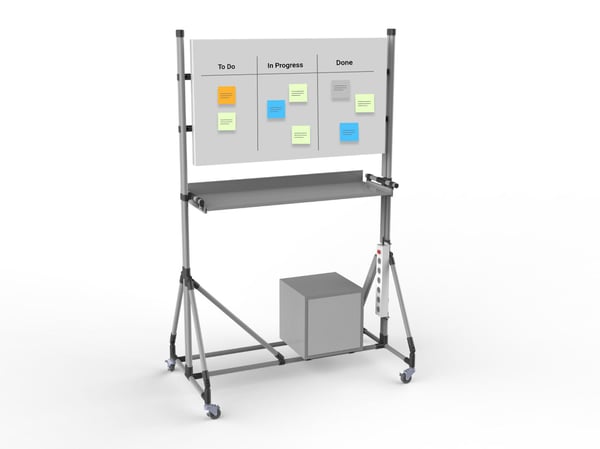
Structure of a Kanban board
A typical Kanban board consists of the following elements:
-
Columns: The columns on the board represent the different phases or states that a task goes through as it is processed. Typical columns are "To Do," "In Progress," and "Done." Depending on the need and process, additional columns can be added to more accurately represent the flow of work.
-
Cards: Cards are small visual representations of tasks or work steps. Each card contains information about the task, such as a description, a responsible person, and possibly a due date.
Use of a Kanban board
There are several steps to using a Kanban board:
-
Record tasks: New tasks or work steps are noted on cards and placed in the first column, often called "To Do." These are tasks waiting to be worked on.
-
Moving the cards: When a task is started, its card is moved to the next column, usually "In Progress" (from left to right). This indicates that work on that task is active.
-
Track progress: Team members can easily track the progress of the work by the position of the cards on the board. They can see which tasks are in progress and which are already completed.
-
Limit work: Each column on the board has a limited capacity, which indicates the maximum number of tasks that can be in it at the same time. This helps to avoid overload and bottlenecks.
-
Prioritization: Team members can adjust the order of tasks on the board based on priorities. Important tasks can be moved up to ensure they get done first.
-
Continuous Update: The Kanban board is continuously updated as tasks progress. When a task is completed, its board is moved to the "Completed" column.
Kanban boards can be physically mounted on a wall or digitally created in dedicated software tools, depending on the needs and preferences of the team.
What are Kanban cards?
Kanban cards are small visual representations of tasks or work steps on a Kanban board. Each card represents a specific task and contains information such as a description, the person responsible, and possibly a due date. These cards are moved around the Kanban board to track and organize the progress of tasks in the work process. They are used to transparently visualize tasks and provide team members with a clear overview of the status of the work.
Kanban cards are versatile and can be adapted differently in companies. Their design depends on the respective area of application (e.g. management level vs. production) the technology level of the company and the information relevant for the company. This means that the design of a Kanban card can be as individual as the number and naming of the columns on a Kanban board.
In lean production Kanban cards often look like this example, mentioning aspects like the article number, name, amount and places of storage and use. Kanban cards used for project management, would of course include totally different information instead.

Advantages of Kanban compared to other agile project management methods
The advantages of Kanban compared to other agile project management or lean management methods are:
-
Flexibility: Kanban allows high flexibility and adaptability to changing requirements and priorities.
-
Simplicity: Kanban is easy to understand and does not require complex roles or ceremonies.
-
Efficiency: By limiting work in progress (WIP), bottlenecks are minimized, which increases efficiency.
-
Transparency: The Kanban board provides clear visibility into the work process and the status of tasks.
-
Continuous improvement: Kanban promotes continuous improvement and adaptation of the work process.
-
Suitable for different teams: Kanban is suitable for teams of different sizes and industries.
-
Lower planning complexity: Compared to other agile methods such as Scrum, Kanban requires less planning effort.
-
Focus on delivery: Kanban emphasizes continuous delivery of value and results.
-
Fewer work interruptions: Kanban minimizes interruptions because tasks are pulled based on capacity and need.
-
Customer-centric: Kanban focuses on the needs of customers and allows for quick adaptation to their requirements.
Kanban vs. Scrum: similarities and differences
Kanban and Scrum have some similarities and differences. Here is a brief summary of the most important ones:
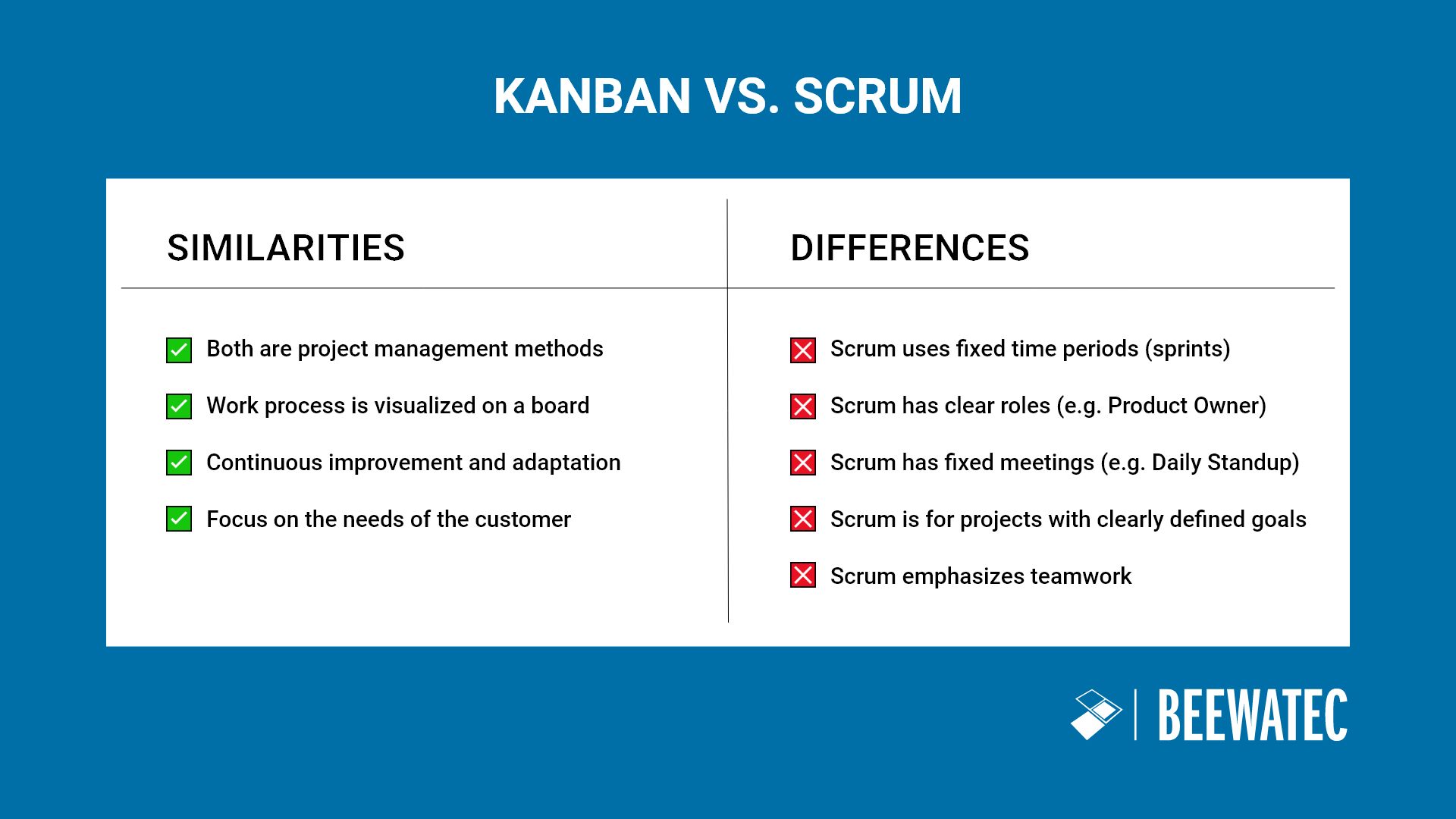
Similarities:
-
Both are agile project management methods.
-
Visualization of the work process on a board.
-
Emphasis on continuous improvement and adaptation.
-
Focus on the needs of the customer.
Differences:
-
Scrum uses fixed time periods (sprints), while Kanban is continuous.
-
Scrum has clear roles (Scrum Master, Product Owner), while Kanban does not prescribe fixed roles.
-
Scrum has fixed meetings and ceremonies (Sprint Planning, Daily Standup), Kanban has no fixed ceremonies.
-
Scrum is good for projects with clearly defined goals, Kanban is more flexible and suitable for continuous work processes.
-
Scrum emphasizes teamwork, while Kanban encourages individual responsibility.
Overall, both methods are effective, but they are better suited for different situations and workflows.
Where is Kanban used? Application of Kanban and examples
Kanban is used in a variety of industries and work areas to optimize work processes and improve workflow. Here are some application examples for Kanban:
-
Software Development: Kanban is commonly used in software development to organize work on software projects. Developers use Kanban boards to track tasks such as feature development, bug fixing, and code reviews.
-
IT Operations: IT teams use Kanban to streamline the operation of IT systems, manage tickets for incidents and updates, and deliver IT services.
-
Customer Support: Customer support teams use Kanban to track customer requests and issues. Tasks can be tracked from request to processing to resolution on the Kanban board.
-
Marketing and content creation: marketing teams use Kanban to plan and track marketing campaigns, content creation, and social media activities.
-
Project management: Kanban can be used in various projects and industries to track project progress, assign tasks, and streamline workflow.
-
Manufacturing and Production: In the manufacturing industry, Kanban is widely used to manage material flow and production efficiency. The "Kanban principle" was originally developed in the automotive industry.
-
Human resource management: HR teams can use Kanban to manage the hiring process, from candidate recruitment to hiring.
-
Logistics and supply chain management: Kanban can be used in logistics and supply chain management to manage the flow of goods and inventory.
-
Education: teachers and educational institutions can use Kanban to plan curriculum, track assignments for students, and streamline the learning process.
-
Healthcare: Hospitals and medical facilities can use Kanban to track patient records, treatment plans, and resource management.
Overall, Kanban can be used in almost any industry and in different teams and organizations to improve the work process, increase efficiency and make work more transparent.
How BeeWaTec supports the Kanban method
BeeWaTec supports the Kanban method in concrete ways by offering specially developed operating materials from its pipe-racking system:
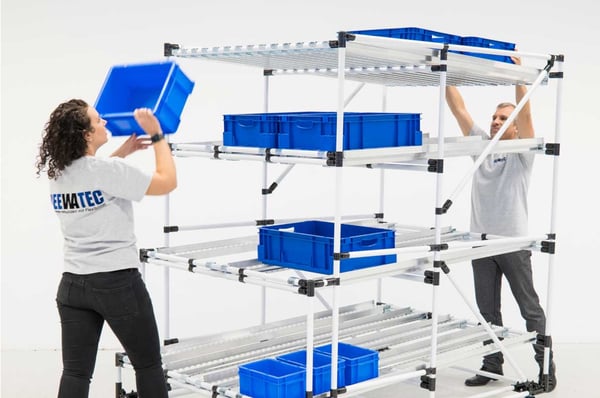
-
Whiteboard and Kanban boards: With the pipe-racking system by G.S. ACE from BeeWaTec, whiteboards and Kanban boards can be easily and quickly implemented. These boards allow companies to visualize their work process, track tasks and transparently display the inventory of materials - all important aspects of the Kanban method.
-
Flow racks: BeeWaTec offers flow racks that are ideal for implementing Kanban in production. These racks allow for easy storage and retrieval of materials and ensure a continuous flow of materials, which is a key principle of the Kanban method.
-
Assembly workstations: BeeWaTec designs assembly workstations that are tailored to the needs of lean production and the kanban method. These workstations are designed to support efficient assembly and the smooth operation of Kanban systems.
-
Flexible adaptation: BeeWaTec offers the possibility to flexibly adapt operating equipment to the specific requirements of companies. This is in line with the Flexible Kanban Method, where operating resources can be adapted to changing requirements.
By providing these specialized operating resources and the possibility of flexible adaptation, BeeWaTec helps companies to successfully implement the Kanban method in their production processes. This helps to optimize the flow of materials, increase value creation and improve efficiency, which in turn is in line with the goals of the Kanban method, especially in the context of the Toyota principle of Lean Production / Kaizen.
You can also check out our partner KanbanBOX. They are speciallized in the implementation of a innovative E-Kanban system throughout the whole supply chain.
Conclusion and outlook
Overall, Kanban will play an important role in a business world characterized by change, competition and the need to satisfy customers. It provides organizations with the tools and principles to operate more efficiently and respond to today's challenges. Kanban enables teams and organizations to increase agility and adaptability while maximizing customer satisfaction.
Here are some of the challenges companies face and how Kanban helps:
-
Rapid change: Markets and customer requirements are changing rapidly. Companies need to be agile and able to adapt quickly. Kanban makes it possible to continuously adjust the work process to respond to change.
-
Competition: Competition in many industries is intense. Companies need to work more efficiently to stay competitive. Kanban helps to optimize the flow of work and reduce waste.
-
Customer centricity: Customers have high expectations for products and services. Kanban emphasizes delivering value to customers and helps focus on their needs.
-
Digital transformation: Companies need to adapt to digital work environments. Kanban can be easily integrated with digital tools to promote collaboration and transparency in virtual teams.
-
Complexity: Projects and work processes often become more complex. Kanban provides clear visualization and structuring to manage complexity and stay on top of things.
-
Increasing efficiency: Companies are looking to increase efficiency and make the best use of resources. Kanban makes it possible to optimize the work process and minimize bottlenecks.
-
Continuous improvement: The need for continuous improvement remains in order to optimize processes and reduce costs. Kanban promotes this continuous improvement culture.
Implement Kanban with ideal operating resources
With our modular system you can implement any solution you need. Discover your possibilities, existing solutions or build your own material flow system with BEEVisio in 3D.



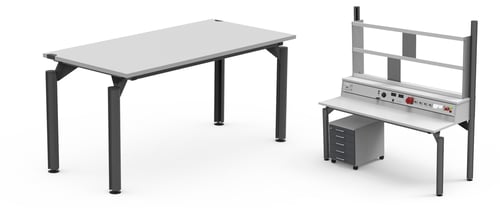
_Web_01_01.jpg?width=1240&name=Beewatec-3-(37)_Web_01_01.jpg)


